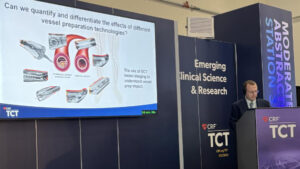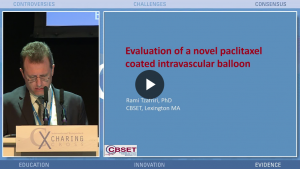FOCUS ON PERIPHERAL ARTERY DISEASE (PAD)
CBSET's approach to the study of novel PAD therapies
CBSET is committed to the development of novel experimental and computational models for peripheral artery disease (PAD), defining the barrier effects of tissue components on drugs of interest and evaluating novel endovascular therapies. CBSET's scientists have published a range of data and analyses on PAD treatments and related therapies.
Scientific papers/presentations related to novel PAD therapies:
 Imaging-Based Evaluation and Differentiation of Vessel Preparation Technologies in a Porcine Model of Peripheral Artery Stenosis. Rami Tzafriri, Jay Budrewicz, Anna Maria Spognardi, Eric A. Secemsky. Presentation at TCT, October 23-26, 2023, San Francisco, CA.
Imaging-Based Evaluation and Differentiation of Vessel Preparation Technologies in a Porcine Model of Peripheral Artery Stenosis. Rami Tzafriri, Jay Budrewicz, Anna Maria Spognardi, Eric A. Secemsky. Presentation at TCT, October 23-26, 2023, San Francisco, CA.
 Investigating Balloon-Vessel Contact Pressure Patterns in Angioplasty: In Silico Insights for Drug-Coated Balloons. Stratakos E, Antonini L, Poletti G, Berti F, Tzafriri AR, Petrini L, Pennati G. Ann Biomed Eng. 2023 Sep 26. doi: 10.1007/s10439-023-03359-y. Epub ahead of print. PMID: 37751027.
Investigating Balloon-Vessel Contact Pressure Patterns in Angioplasty: In Silico Insights for Drug-Coated Balloons. Stratakos E, Antonini L, Poletti G, Berti F, Tzafriri AR, Petrini L, Pennati G. Ann Biomed Eng. 2023 Sep 26. doi: 10.1007/s10439-023-03359-y. Epub ahead of print. PMID: 37751027.
 Lesion Modification with a Micro-Incision Vessel Preparation System Enhances Balloon-Based Drug Delivery in Complex Porcine Restenotic Lesions. Rami Tzafriri, Jay Budrewicz, Lynn Bailey, Peter Markham et al. Presented at LINC 2021, January 25, 2021.
Lesion Modification with a Micro-Incision Vessel Preparation System Enhances Balloon-Based Drug Delivery in Complex Porcine Restenotic Lesions. Rami Tzafriri, Jay Budrewicz, Lynn Bailey, Peter Markham et al. Presented at LINC 2021, January 25, 2021.
Balloon-based drug coating delivery to the artery wall is dictated by coating micro-morphology and angioplasty pressure gradients Abraham R. Tzafriri, Benny Muraj, Fernando Garcia-Polite et al. Biomaterials. 2020 Nov;260:120337.
Six Month Safety Evaluation Of The Chocolate Touch™ Drug-coated Balloon Catheter In The Swine Peripheral Artery Model. Abraham R. Tzafriri, Anna Maria Spognardi, LynnBailey, John Keating, Peter Markham, Gary Binyamin, Maria Pizarro, Eitan Konstantino, Elazer R. Edelman. JACC: Cardiovascular Interventions Volume 13, Issue 4, Supplement, 24 February 2020, Pages S31-S32.
Taking paclitaxel coated balloons to a higher level: Predicting coating dissolution kinetics, tissue retention and dosing dynamics. Abraham R.Tzafriri, Sahil A. Parikh, Elazer R. Edelman. Journal of Controlled Release. Volume 310, 28 September 2019, Pages 94-102.
 Enhanced Plaque Modification of Cadaveric Human Calcified Peripheral Arteries Treated with a Vessel Preparation System. Video interview at CRT19. CBSET’s Director of Research and Innovation, Rami Tzafriri, PhD, discusses CBSET’s human cadaver model assessment of a vessel preparation system and the attributes of this particular technology that suggest it might be conducive to enhancing drug absorption.
Enhanced Plaque Modification of Cadaveric Human Calcified Peripheral Arteries Treated with a Vessel Preparation System. Video interview at CRT19. CBSET’s Director of Research and Innovation, Rami Tzafriri, PhD, discusses CBSET’s human cadaver model assessment of a vessel preparation system and the attributes of this particular technology that suggest it might be conducive to enhancing drug absorption.
Calcified plaque modification alters local drug delivery in the treatment of peripheral atherosclerosis. Abraham R. Tzafriri, Fernando Garcia-Polite, Brett Zani et al, Journal of Controlled Release, Volume 264, 28 October 2017, Pages 203-210.
 Evaluation of a novel paclitaxel coated intravascular balloon. Abraham R. Tzafriri, PhD. Presented at CX 2017 – The Charing Cross International Symposium, April 25-28, Kensington, London, UK.
Evaluation of a novel paclitaxel coated intravascular balloon. Abraham R. Tzafriri, PhD. Presented at CX 2017 – The Charing Cross International Symposium, April 25-28, Kensington, London, UK.
Mechanisms Underlying Drug Delivery to Peripheral Arteries. Li J, Tzafriri R, Patel SM, Parikh SA. Interventional Cardiology Clinics. 2017 Apr;6(2):197-216. doi: 10.1016/j.iccl.2016.12.004.
Multiple drug coated balloon exposures increase arterial permeability and drug retention. Rami Tzafriri; Peter Markham; Brett Zani; Steve Alston; Elazer Edelman. Presented at: Innovations in Cardiovascular Interventions (ICI), Dec 4-6, 2016, Tel Aviv, Israel.
Two Blades-Up Runs Using the JetStream Navitus Atherectomy Device Achieve Optimal Tissue Debulking of Nonocclusive In-Stent Restenosis: Observations From a Porcine Stent/Balloon Injury Model. Shammas NW, Aasen N, Bailey L et al. Journal of Endovascular Therapy. 2015 Aug;22(4):518-24.
Effects of Orbital Atherectomy Treatment on Drug Absorption in Calcified Peripheral Arteries. Elazer R. Edelman, MD. Presented at CRT15 – Cardiovascular Research Technologies (CRT); 2015 Feb 21-24; Washington, DC.
Mechanisms of Tissue Uptake and Retention in Zotarolimus-Coated Balloon Therapy. Vijaya B. Kolachalama, Stephen D. Pacetti, Joseph W. Franses et al. Circulation. 2013;127:2047-2055.
Correlative evaluation of variable pressure-scanning electron microscopy to histology methods for vascular tissues. P. Seifert, K. Regan, B.G. Zani, G. Wong, J. Stanley. Journal of Histotechnology, 2013 March; 36 (1): 25-29.
CBSET, training the next generation of PAD therapy researchers:
CBSET is leveraging its expertise in PAD-related animal computational models to support its medical device industry sponsors and to train the next generation of physicians and scientist working in this field. Both of these missions have been recognized and are partially supported by DECODE, a European Union Horizon 2020 / Marie Curie training grant.
The project leading to this application has received funding from the European Union’s Horizon 2020 research and innovation programme under the Marie Skłodowska-Curie grant agreement No 956470.
PAD News:

DECODE Network Meeting 5: Medical Device Testing during the innovation cycle – Impressions of an ESR7

DECODE Network Meeting 5: Medical Device Testing during the innovation cycle, April 17-19, 2024

ICI 2024: Porcine Model of Catheter Based Treatment of Pulmonary Embolization

Bioengineering: Cardiovascular Tissue Engineering Models for Atherosclerosis Treatment Development

TCT 2023: Imaging-Based Evaluation and Differentiation of Vessel Preparation Technologies in a Porcine Model of Peripheral Artery Stenosis

1st DECODE Workshop: Recent advances on experimental analysis on DCBs, Oct 5-6, 2023

Annals of Biomedical Engineering: Investigating Balloon-Vessel Contact Pressure Patterns in Angioplasty: In Silico Insights for Drug-Coated Balloons

1st DECODE Networking Meeting: Current state of the art in the use of DCBs in clinical practice, Jan 16-18, 2023

1st DECODE Summer School: Advances in Multiscale Modelling for Cardiovascular Use, July 18-21 2022

DECODE Kickoff Virtual Meeting, March 19, 2021

MD+DI: COVID-19 One Year Later: Can’t Keep a Medical Device Startup Down

Cardiovascular News: FLEX Vessel Prep™ System Data Presented During Leipzig Interventional Course (LINC) 2021

LINC 2021: Lesion Modification with a Micro-Incision Vessel Preparation System Enhances Balloon-Based Drug Delivery in Complex Porcine Restenotic Lesions

Endovascular Today: CBSET Preclinical Study Shows Balloon-Based Drug Delivery Is Critically Dependent on Coating Micromorphology

Medical Alley: COVID-19 and Quarantine – Can’t keep a medical device start-up down

CRT 2020: Six Month Safety Evaluation Of The Chocolate Touch™ Drug-coated Balloon Catheter In The Swine Peripheral Artery Model

Endovascular Today: Computational Model Suggests a New Paradigm for Accelerated Treatment Optimization With Paclitaxel Devices

Endovascular Today: Lesion Preparation Using Diamondback 360 OAS Shown to Enhance Paclitaxel Distribution in Calcified PAD

ICI 2016: Multiple drug coated balloon exposures increase arterial permeability and drug retention

Endovascular Today: Preclinical Study Evaluates Primary Lesion Treatment With CSI’s Orbital Atherectomy System Before Drug Delivery in Calcified PAD


